Impacts and Climate Change Adaptation of Agrometeorological Services among the Maize Farmers of West Tamil Nadu
Abstract
:1. Introduction
1.1. Status of AAS Dissemination in India
1.2. Maize Production Statistics in India
2. Materials and Methods
2.1. Study Area: Parambikulam–Aliyar Basin
2.2. Dissemination of AAS to the Farming Communities
2.3. Verification of Skill Score of the Forecasts
2.4. Crop Simulation Modeling to Understand the Anticipated Impacts on Maize Yield
3. Results
3.1. Climate-Related Disasters Profile of the Study Area
3.2. Observed Weather during the Maize-Growing Period (2021–2022)
3.3. Qualitative Scores and Skills of the Weather Forecast Verification
3.4. Responses/Feedback of the Farmers on AAS Services
3.5. Maize Crop Simulation Modeling Using DSSAT 4.7
4. Conclusions and Way Forward
- I.
- Early warning systems must be established at the village level to abate weather-based agrarian risks; for this, a denser network of automatic weather stations must be set up.
- II.
- Agrometeorological research communities must try to focus on the need to establish stronger links to connect science, policy, and farming communities using ICT tools.
- III.
- The government must take necessary actions for institutional collaborations and promote farmers’ collectives for holistic development.
- IV.
- The usability of weather forecasts among stakeholders must be enhanced at the village level with timely dissemination with periodic assessments of data.
- V.
- External funding (both national and international) must be encouraged to accelerate the adaptation momentum to enhance early warning and its usability to secure crop and farm income sustainably.
- VI.
- Sustainable cultivation practices must be promoted at the village level in order to achieve global targets and align crop production systems to UN Sustainable Development Goals such as climate action, no poverty, zero hunger, etc.
Author Contributions
Funding
Institutional Review Board Statement
Informed Consent Statement
Data Availability Statement
Acknowledgments
Conflicts of Interest
References
- Pörtner, D.C.; Roberts, M.; Tignor, E.S.; Poloczanska, K.; Mintenbeck, A.; Alegría, M.; Craig, S.; Langsdorf, S.; Löschke, V.; Möller, A. (Eds.) IPCC, 2022: Summary for Policymakers. In Climate Change 2022: Impacts, Adaptation, and Vulnerability; Contribution of Working Group II to the Sixth Assessment Report of the Intergovernmental Panel on Climate Change; Cambridge University Press: Cambridge, UK, 2022; In Press. [Google Scholar]
- FAO 2015, How to Feed the World in 2050. Available online: https://www.fao.org/fileadmin/templates/wsfs/docs/expert_paper/How_to_Feed_the_World_in_2050.pdf (accessed on 18 April 2018).
- Rahman, M.M.; Rahman, M.M.; Momotaz, M. Environmental quality evaluation in Dhaka City Corporation–using satellite imagery. Proc. Inst. Civil. Eng.-Urban Design Plan. 2019, 172, 13–25. [Google Scholar] [CrossRef]
- Raj, S.; Paul, S.K.; Chakraborty, A.; Kuttippurath, J. Anthropogenic forcing exacerbating the urban heat islands in India. J. Environ. Manag. 2020, 257, 110006. [Google Scholar] [CrossRef]
- Mishra, V.; Bhatia, U.; Tiwari, A.D. Bias-corrected climate projections for South Asia from Coupled Model Intercomparison Project-6. Sci. Data 2020, 7, 338. [Google Scholar] [CrossRef]
- Mishra, V.; Mukherjee, S.; Kumar, R.; Stone, D. Heat wave exposure in India in current, 1.5 °C, and 2.0 °C worlds. Environ. Res. Lett. 2017, 12, 124012. [Google Scholar] [CrossRef]
- Nathan, K.K. Assessment of Recent Droughts in Tamil Nadu.Drought Network News520 (1994–2001). Paper 57. 1995. 1995. Available online: http://digitalcommons.unl.edu/droughtnetnews/57 (accessed on 4 April 2021).
- Mani Murali, R.; Ankita, M.; Amrita, S.; Vethamony, P. Coastal vulnerability assessment of Puducherry coast, India, using the analytical hierarchical process. Nat. Hazards Earth Syst. Sci. 2013, 13, 3291–3311. [Google Scholar] [CrossRef] [Green Version]
- IPCC. Climate Change 2014: Impacts, Adaptation, and Vulnerability. In Contribution of Working Group II to the Fifth Assessment Report of the Intergovernmental Panel on Climate Change; Field, C.; Barros, V.; Mach, K.; Mastrandrea, M. (Eds.) Cambridge University Press: Cambridge, UK; New York, NY, USA, 2014. [Google Scholar]
- Bendapudi, R.; Kumbhar, N.; Gaikwad, P.; Lobo, C. Agro-Met Services and Farmer Responsiveness to Advisories: Implications for Climate Smart Agriculture. In Handbook of Climate Change Resilience; Earth and Environmental Science E-Book; Filho, W.L., Ed.; Springer Nature: Berlin, Germany, 2019. [Google Scholar] [CrossRef]
- Gill, K.K.; Babuta, R. Reliability analysis of Medium Range Weather Forecasts in Central Plain Region of Punjab. Indian J. 2016, 56, 240–360. [Google Scholar]
- Basso, B.; Liu, L.; Ritchie, J.T. A comprehensive review of the CERES-Wheat, -Maize and –Rice Models’ Performances. Adv. Agron. 2016, 136, 27–132. [Google Scholar]
- Kumar, N.S.; Singh, A.K.; Aggarwal, P.K.; Rao, V.U.M.; Venkateswaru, B. Climate Change and Indian Agriculture Salient Achievements from ICAR Network Project; Indian Agricultural Research Institute publications: New Delhi, India, 2012. [Google Scholar]
- Bhuvan. Available online: https://bhuvan-app1.nrsc.gov.in/thematic/thematic/index.php (accessed on 5 August 2022).
- IMD, Standard Operating Procedure (SOP) For Agromet Advisory Services. 2020. Available online: https://mausam.imd.gov.in/imd_latest/contents/pdf/gkms_sop.pdf (accessed on 21 May 2020).
- Kothiyal, S.; Singh, R.; Nain, A.; Padalia, H.; Chaturvedi, G. Verification of Medium Range Weather Forecast for Udham Singh Nagar Region in order to Improve Methodology Followed. Int. J. Curr. Microbiol. Appl. Sci. 2017, 6, 1995–2005. [Google Scholar] [CrossRef]
- Rathore, L.S.; Parvinder, M. 2008: Economic Impact Assessment of AgroMeteorological Advisory Service of NCMRWF; Report no. NMRF/PR/01/2008; NCMRWF, Ministry of Earth Sciences, Government of India: Noida, India, 2008; 104p. [Google Scholar]
- Hoogenboom, G.; Jones, J.W.; Wilkens, P.W.; Porter, C.H.; Boote, K.J.; Hunt, L.A.; Singh, U.; Lizaso, J.L.; White, J.W.; Uryasev, O.; et al. Decision Support System Foragrotechnology Transfer (DSSAT) Version 4.5 [CD-ROM]; University of Hawaii: Honolulu, HI, USA, 2010. [Google Scholar]
- Jones, P.G.; Thornton, P.K. The potential impacts of climate change on maize production in Africa and Latin America in 2055. Glob. Environ. Chang. 2003, 13, 51–59. [Google Scholar] [CrossRef]
- Jones, C.A.; Kiniry, J.R. CERES-Maize: A Simulation Model of Maize Growth and Development; Texas A&M University Press: College Station, TX, USA, 1986. [Google Scholar]
- Bassu, S.; Brisson, N.; Durand, J.-L.; Boote, K.; Lizaso, J.; Jones, J.W.; Rosenzweig, C.; Ruane, A.C.; Adam, M.; Baron, C.; et al. How do various maize crop models vary in their responses to climate change factors? Glob. Chang. Biol. 2014, 20, 2301–2320. [Google Scholar] [CrossRef] [Green Version]
- Rahman, N.; Rahman, M.; Baten, M.; Hossain, M.; Hassan, S.; Ahmed, R.; Hossain, A.; Aziz, M.; Haque, M.; Halder, T.; et al. Weather Forecast Based Rice Advisory Services in Bangladesh. Bangladesh Rice J. 2021, 25, 51–74. [Google Scholar] [CrossRef]
- Talaviya, T.; Shah, D.; Patel, N.; Yagnik, H.; Shah, M. Implementation of artificial intelligence in agriculture for optimisation of irrigation and application of pesticides and herbicides. Artif. Intell. Agric. 2020, 4, 58–73. [Google Scholar] [CrossRef]
- Riahi, K.; Van Vuuren, D.P.; Kriegler, E.; Edmonds, J.; O’neill, B.C.; Fujimori, S.; Bauer, N.; Calvin, K.; Dellink, R.; Fricko, O.; et al. The shared socioeconomic pathways and their energy, land use, and greenhouse gas emissions implications: An overview. Glob. Environ. Chang.: Hum. Policy Dimens. 2017, 42, 153–168. [Google Scholar] [CrossRef] [Green Version]
- McDermid, S.; Gowtham, R.; Bhuvaneswari, K.; Vellingiri, G. The impacts of climate change on Tamil Nadu rainfed maize production: A multi-model approach to identify sensitivities and uncertainties. Curr. Sci. 2016, 110, 1257–1271. [Google Scholar]
- Rosenzweig, C.; Hillel, D. Handbook of Climate Change and Agroecosystems: The Agricultural Model Intercomparison and Improvement Project (AgMIP) Integrated Crop and Economic Assessments—Joint Publication with American Society of Agronomy, Crop Science Society of America, and Soil Science Society of America; Imperial College Press: London, UK, 2015. [Google Scholar] [CrossRef]
- Gowtham, R.; Bhuvaneshwari, K.; Senthil, A.; Dhasarathan, M.; Revi, A.; Bazaz, A. Impact Of Global Warming (1. 5 °C) On The Productivity Of Selected C3 And C4 Crops Across Tamil Nadu. J. Agrometeorol. 2020, 22, 7–17. [Google Scholar]
- Hasanuzzaman, M.; Nahar, K.; Fujita, M. Extreme Temperatures, Oxidative Stress and Antioxidant Defense in Plants. In Abiotic Stress ÐPlant Responses and Applications in Agriculture; Vahdati, K., Leslie, C., Eds.; In Tech.: Rijeka, Croatia, 2013; pp. 169–205. [Google Scholar]
- Prasad, P.V.V.; Staggenborg, S.A.; Ristic, Z. Impact of drought and heat stress on physiological, growth and yield processes. In Modeling Water Stress Effects on Plant Growth Processes; Ahuja, L.H., Saseendran, S.A., Eds.; ASA—CSSA: Madison, WI, USA. Adv. Agric. Syst. Model. 2009, 1, 301–355. [Google Scholar]
- Ren, X.; Weitzel, M.; O’Neill, B.C.; Lawrence, P.; Meiyappan, P.; Levis, S.; Balistreri, E.; Dalton, M. Avoided economic impacts of climate change on agriculture: Integrating a land surface model (CLM) with a global economic model (iPETS). Clim. Chang. 2018, 146, 517–531. [Google Scholar] [CrossRef] [Green Version]
- Bukovsky, M.S.; Gao, J.; Mearns, L.O.; O’Neill, B.C. SSP-based land-use change scenarios: A critical uncertainty in future regional climate change projections. Earth’s Future 2021, 9, e2020EF001782. [Google Scholar] [CrossRef]
- WMO. 2010. Final report. World Meteorological Organization—Commission For Basic Systems -Opag On Integrated Observing Systems. In Proceedings of the Expert Team on Requirements for Data from Automatic Weather Stations, Sixth Session, Geneva, Switzerland, 22–25 June 2010. [Google Scholar]
- Fei, S.; Hassan, M.A.; Xiao, Y.; Su, X.; Chen, Z.; Cheng, Q.; Duan, F.; Chen, R.; Ma, Y. UAV-based multi-sensor data fusion and machine learning algorithm for yield prediction in wheat. Precis. Agric. 2022, 2022, 1–26. [Google Scholar] [CrossRef]
- De Oliveira Maia, F.C.; Bufon, V.B.; Leão, T.P. Vegetation indices as a Tool for Mapping Sugarcane Management Zones. Precis. Agric. 2022, 2022, 1–22. [Google Scholar] [CrossRef]
- Akhter, R.; Sofi, S.A. Precision agriculture using IoT data analytics and machine learning. J. King Saud Univ.-Comput. Inf. Sci. 2021, 1319–1578. [Google Scholar] [CrossRef]
- Shanko, D. Use of Automatic Weather Stations in Ethiopia; National Meteorological Agency (NMA) Report: Addis Ababa, Ethiopia, 2015. [Google Scholar]
- Naik, P.S.; Singh, M.; Ranjan, J.K. Impact of Climate Change on Vegetable Production and Adaptation Measures. In Abiotic Stress Management for Resilient Agriculture; Minhas, P., Rane, J., Pasala, R., Eds.; Springer: Singapore, 2017. [Google Scholar] [CrossRef]
- Venkateswarlu, B.; Shanker, A.K. Dryland agriculture bringing resilience to crop production under changing climate. In Crop Stress and Its Management: Perspectives and Strategies; Springer: Dordrecht, The Netherlands, 2012; Springer: Dordrecht, The Netherlands, 2012; pp. 19–44. [Google Scholar]
- Patel, N.R.; Yadav, K. Monitoring of spatio-temporal pattern of drought stress by use of integrated drought index over Bundelkhand region, India. Nat. Hazard 2015, 77, 663–677. [Google Scholar] [CrossRef]
- Seneviratne, S.I.X.; Zhang, M.; Adnan, W.; Badi, C.; Dereczynski, A.; Di Luca, S.; Ghosh, I.; Iskandar, J.; Kossin, S.; Lewis, F.; et al. Weather and Climate Extreme Events in a Changing Climate. In Climate Change 2021: The Physical Science Basis. Contribution of Working Group I to the Sixth Assessment Report of the Intergovernmental Panel on Climate Change; Masson-Delmotte, V.P., Zhai, A., Pirani, S.L., Connors, C., Péan, S., Berger, N., Caud, Y., Chen, L., Goldfarb, M.I., Gomis, M., Eds.; Cambridge University Press: Cambridge, UK; New York, NY, USA, 2021; pp. 1513–1766. [Google Scholar] [CrossRef]
- Chattopadhyay, N.; Chandras, S. Agrometeorological advisory services for sustainable development in Indian agriculture. Biodivers. Int. J. 2018, 2, 13–18. [Google Scholar] [CrossRef]
- Rathore, L.S.; Singh, K.K.; Gupta, A. National Centre for Medium-Range Weather Forecasting: Activities, current status and plans. In Proceedings of the National Seminar on Agrometeorology in the New Millennium: Prospectives and Challenges, PAU Ludhiana, India, 20–31, October 2003; pp. 141–147. [Google Scholar]
- Belle, A. 2019. Bangladeshi farmers reap the benefit of new weather forecasts. A report of the end poverty in south Asia, World Bank. Available online: https://blogs.worldbank.org/endpovertyinsouthAsia/Bangladeshi-farmers-reap-benefits-newweather-forecasts (accessed on 27 July 2020).
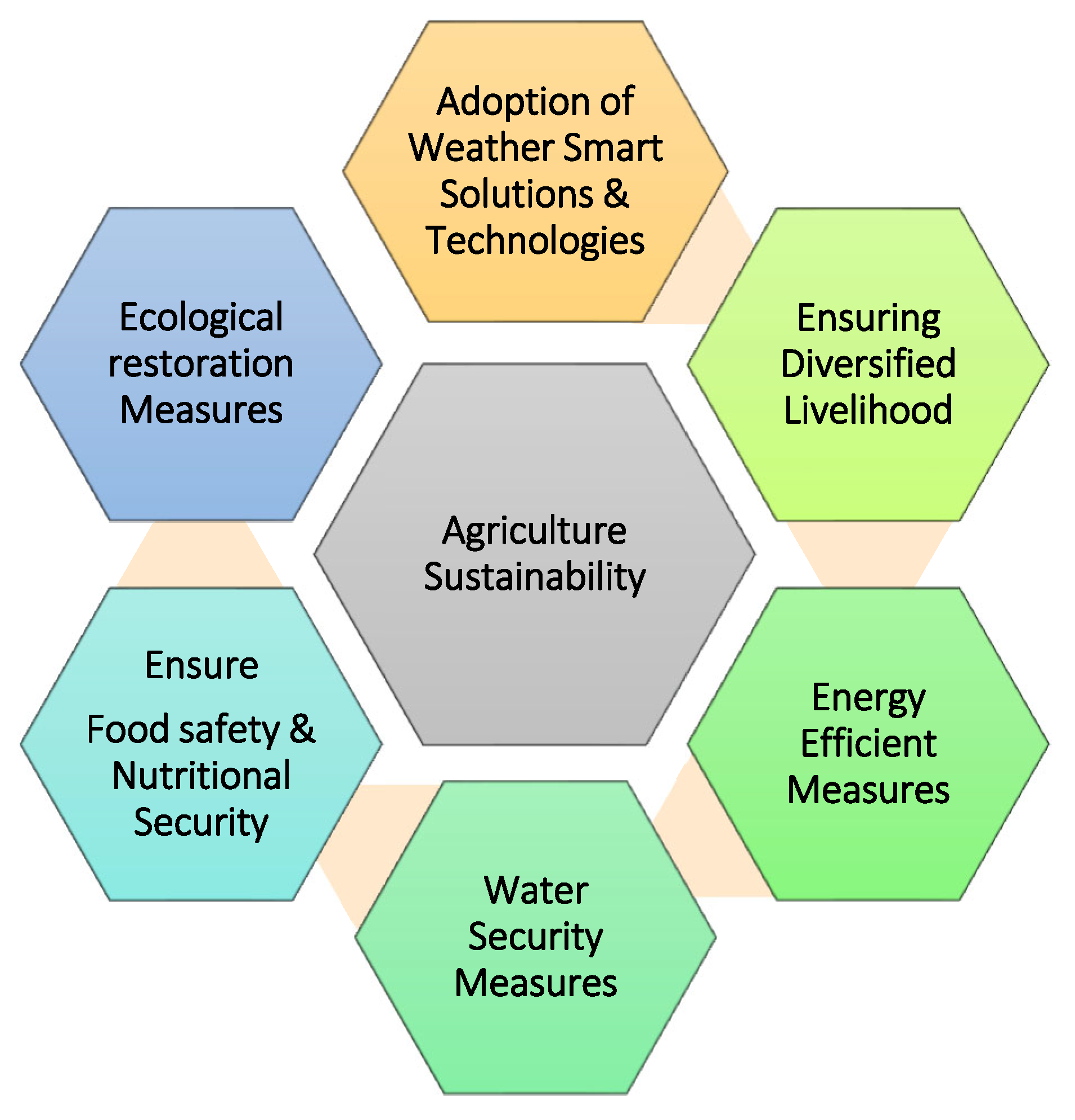

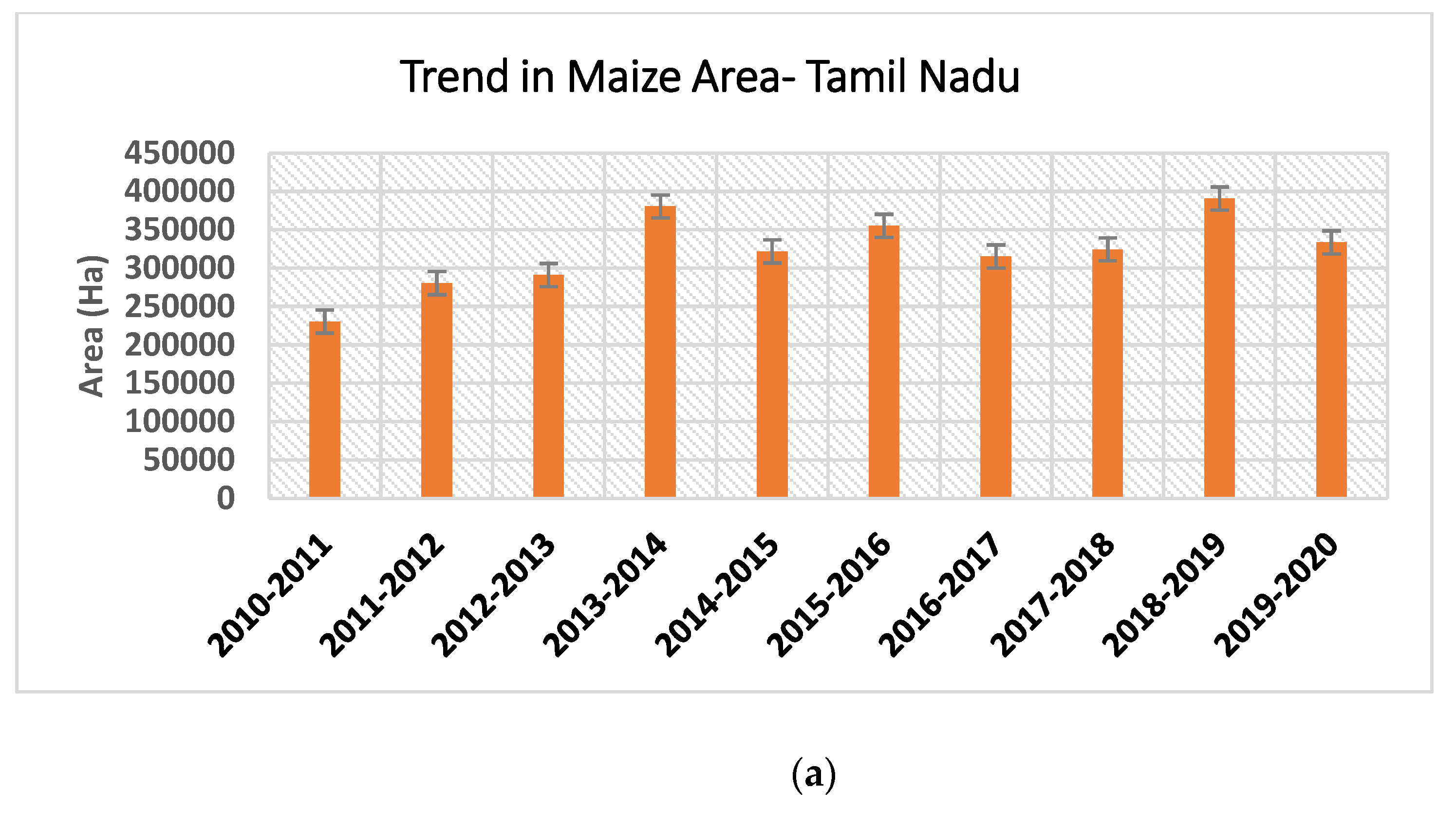
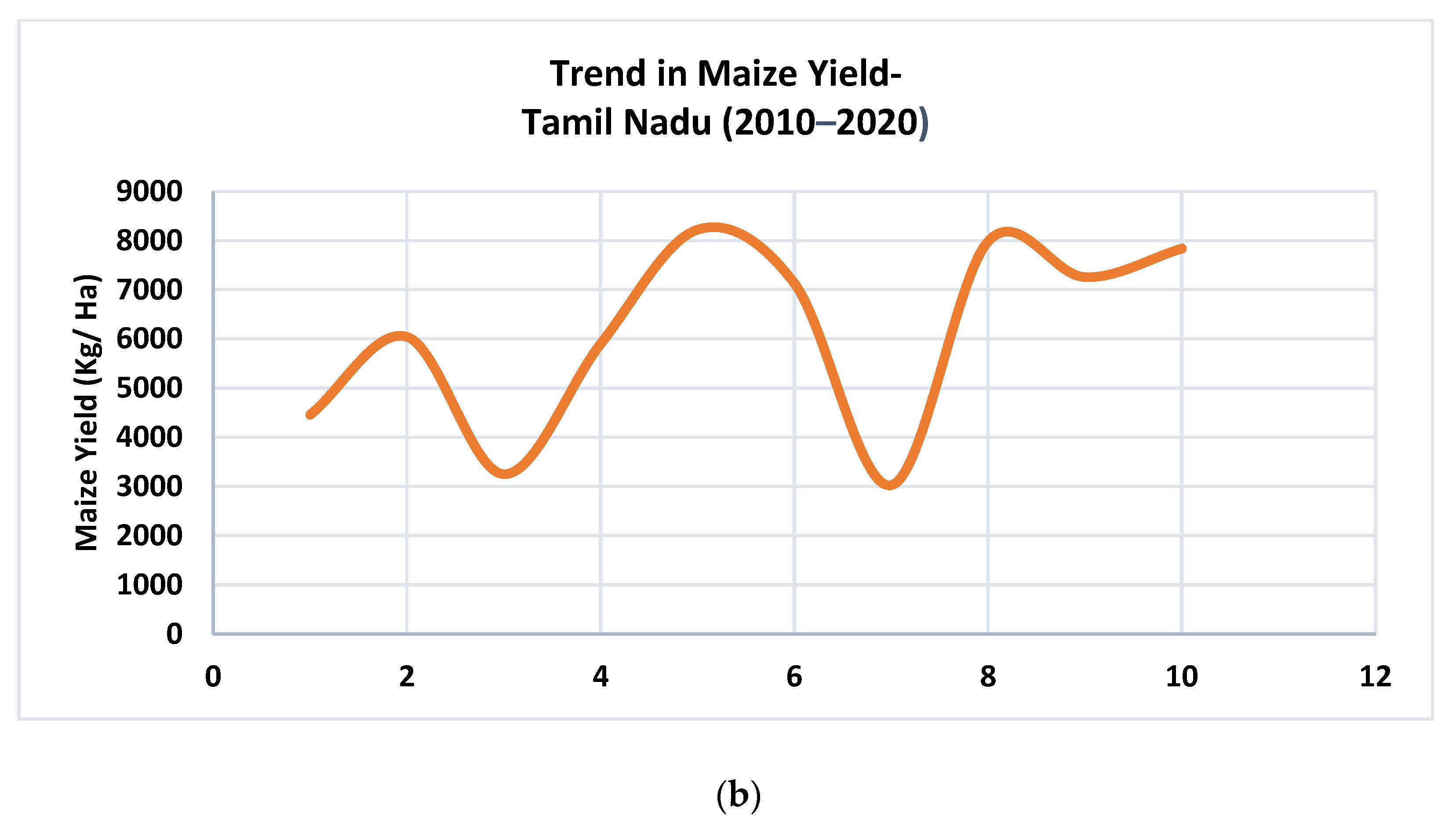
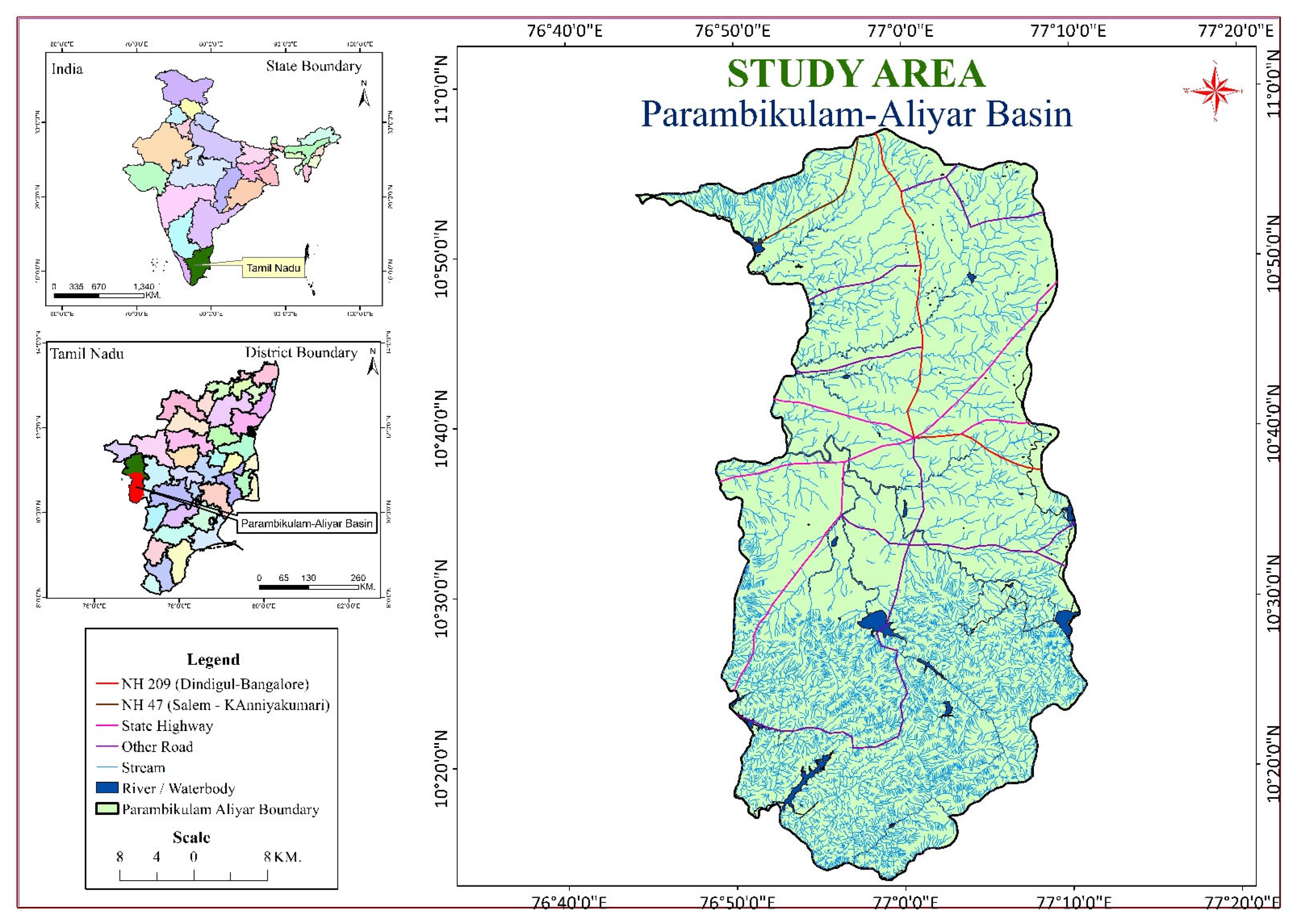
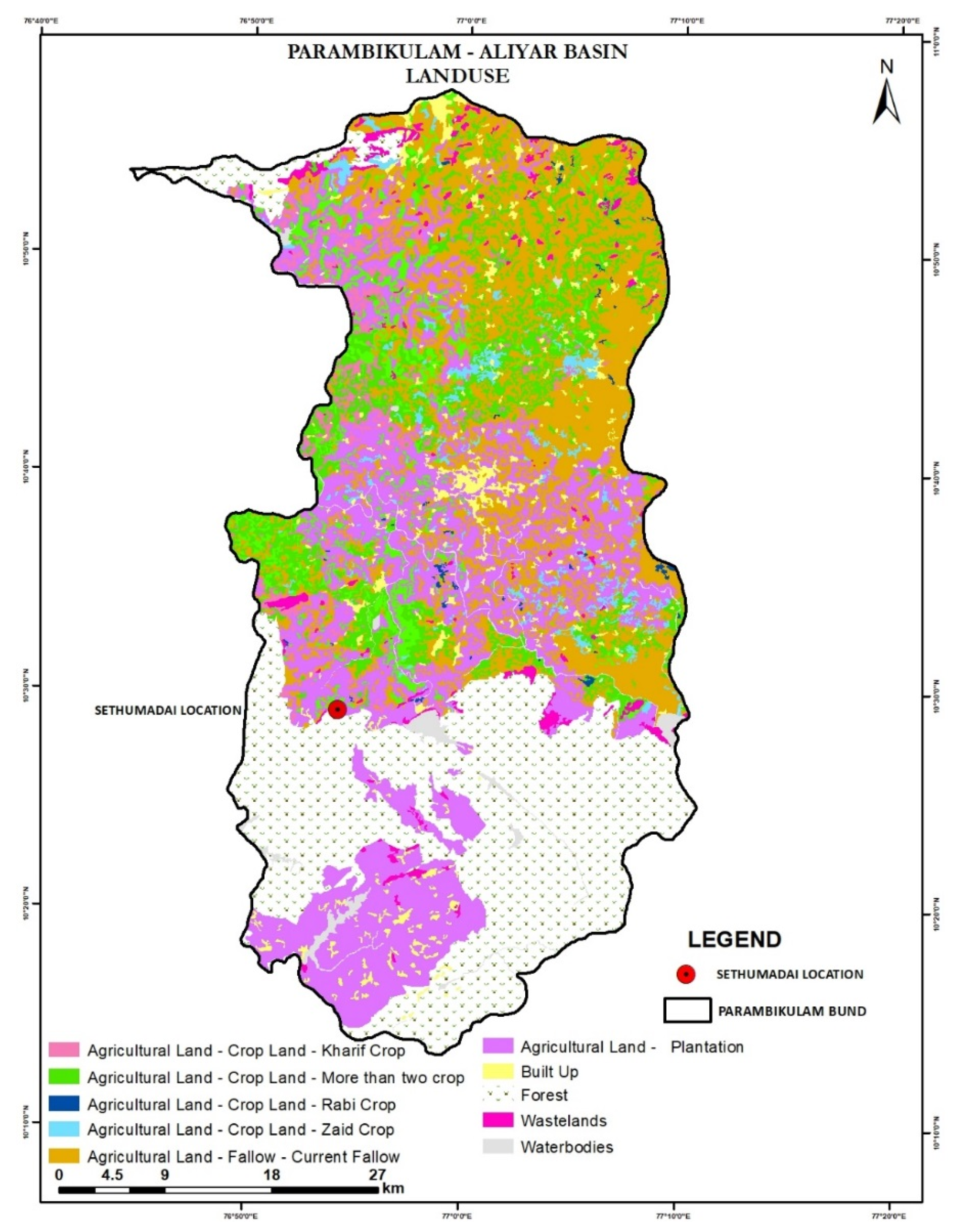
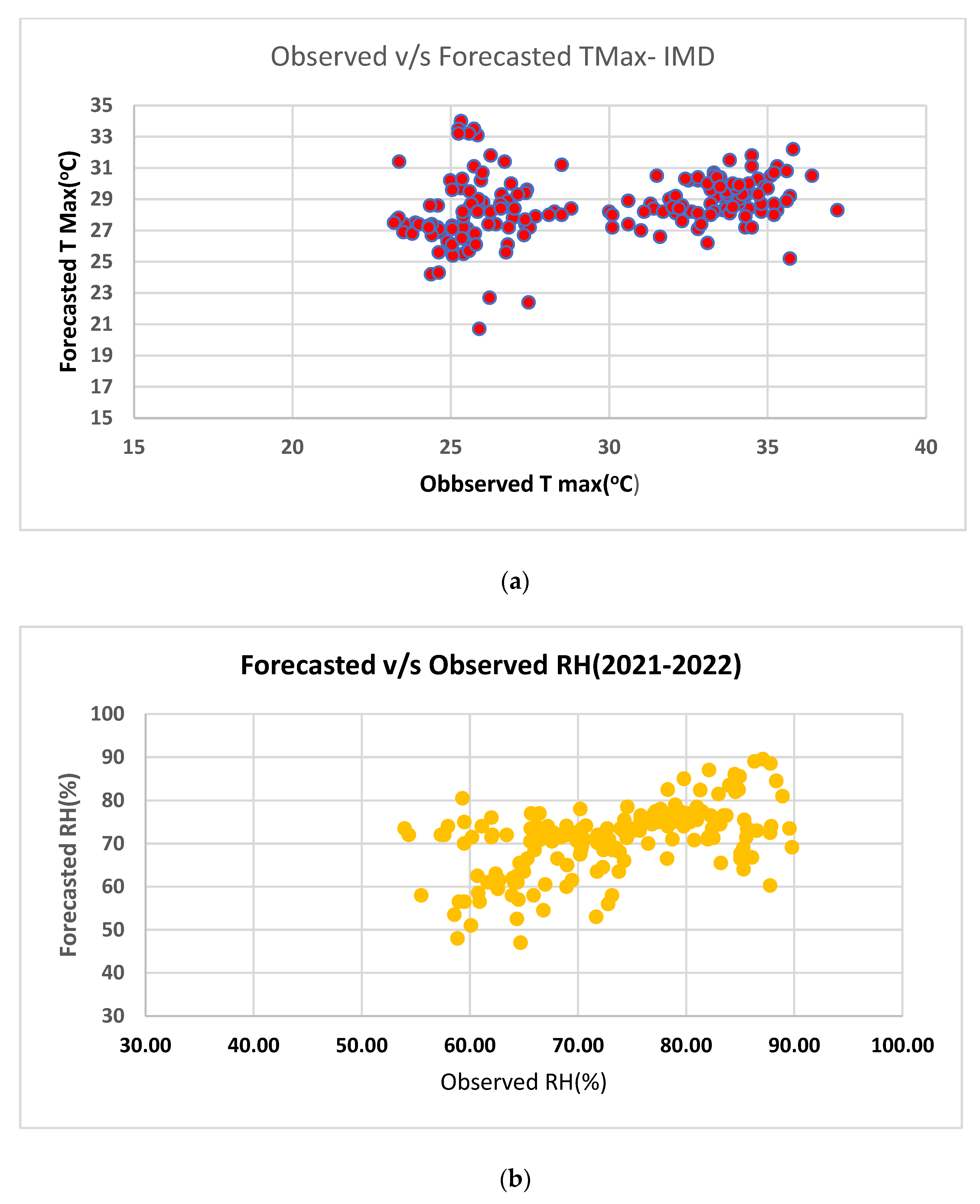





| Year | Events |
|---|---|
| 2001 | Mild Drought |
| 2002 | Mild Drought |
| 2003 | Moderate Drought |
| 2004 | Moderate Drought |
| 2005 | Excess Rain |
| 2008 | Cyclone Nisha-Rain |
| 2010 | Moderately Wet |
| 2011 | Heavy Rain due to Thane Cyclone |
| 2012 | Heavy Rain due to Nilam Cyclone |
| 2014 | Drought |
| 2015 | Excess Rain |
| 2016 | Drought/Vardah cyclone |
| 2018 | Gaja Cyclone Excess Rain |
| 2019 | Fani and Bulbul Cyclone Excess Rain |
| 2020 | Amphan and Nisarga |
| 2021 | Tauktae and Nivar |
| 2022 | Asani Brought Good Rain |
| Skills | Scores |
|---|---|
| Accuracy Ratio | 0.77 |
| Bias Score | 1.44 |
| Probability Of Detection (Hit Rate) | 0.91 |
| False Alarm Ratio | 0.37 |
| Probability Of False Detection (False Alarm Rate) | 0.30 |
| Threat Score (Critical Success Index) | 0.59 |
| Heidke Skill Score | 0.55 |
| Equitable Threat Score (Gilbert Skill Score) | 0.38 |
| Hanssen and Kuipers Discriminant | 0.60 |
| Odds Ratio | 22.86 |
| RMSE | 10.90 |
| Correlation Coefficient (R2) | 0.21 |
| Sl. No. | Comments by the Farmers | Timeline |
|---|---|---|
| 1 | “We came to know through SMS that there won’t be rains hence critical irrigation was given once a week, otherwise the maize crops in the vegetative phase would not have survived during margazhi pattam” | January 2022 |
| 2 | In the early samba * season, crops were saved by preponing the harvests of maize crops one week before because the rainfall forecast for the next five days received from the project showed “No Rainfall”. This was repeatedly mentioned by the farmers during the farmers’ meet organized by Agroclimatic Research Center, Tamil Nadu Agriculture University, Coimbatore, during November 2021 at Anamalai | November 2021 |
| 3 | “We have undertaken the sowing of maize and sorghum only after receiving the rainfall forecast, otherwise, seed loss might have incurred due to heavy precipitation events during September and November”. | September and November 2021 |
| 4 | “This time we are happy that we are receiving weekly weather information/updates at our fingertips; hence, we can plan our farm operations like spraying, fertilization and irrigation properly | October and November 2021 |
| 5 | “Almost all the AAS you have disseminated has the correct weather forecast for the Anamalai region and extension officers, officers of ATMA are also visiting us more often after the launch of this project | December-January 2021–2022 |
| 6 | “During land preparations and sowing, it was difficult to work in the field for long hours due to severe temperature” | September 2021 |
| 7 | It was informed by most of the farmers and extension officers that they received the rainfall forecast well in advance from the Department of Agriculture Extension (DAE), and the forecast was very accurate, and they could use the same ultimately for weather-based farm operation successfully. | |
| 6 | “We are receiving timely Puyal (cyclone) information correctly for the past two years” | November 2021 |
| 7 | “We came to know about the crop boosters like TNAU-Maize Maxim through SMS/Multi-purpose traps like pheromone traps for crop protection and growth through AAS.” | October and December 2021 |
| Degree of Effectiveness of Agromet Advisories and Weather Forecast | ||||
|---|---|---|---|---|
| Sl. No. | Responses | Early Phase of the Project (%) | Mid Phase of the Project (%) | End Phase of the Project (%) |
| 1 | Very Effective | 13.5 | 21 | 29 |
| 2 | Effective | 19.5 | 36 | 48 |
| 3 | Not Effective | 21.9 | 14 | 6 |
| 4 | Don’t Know | 45.1 | 29 | 17 |
| Total | 100* | 100* | 100* | |
| Measures Initiated by (No.) | |||
|---|---|---|---|
| Adaptation Options | AAS * Farmers (n = 82) | Control Farmers (n = 56) | |
| 1 | Changing the timing of sowing | 38 | 12 |
| 2 | Shifting to plantation crops such as coconut/cocoa/nutmeg | 6 | 27 |
| 3 | Shifting to short-duration varieties such as cowpea, sesame, red gram, etc. | 9 | 18 |
| 4 | Changing the timing of fertilizer operation | 25 | 3 |
| 5 | Changing the timing of harvest | 31 | 3 |
| 6 | Shifting to other jobs coir pith/Kozhi pannai (poultry farm)/livestock farm | 2 | 13 |
| 7 | Organic amendments in farming | 34 | 22 |
| 8 | Water harvesting and conservation measures such as pond renovation and mulching | 17 | 11 |
Publisher’s Note: MDPI stays neutral with regard to jurisdictional claims in published maps and institutional affiliations. |
© 2022 by the authors. Licensee MDPI, Basel, Switzerland. This article is an open access article distributed under the terms and conditions of the Creative Commons Attribution (CC BY) license (https://creativecommons.org/licenses/by/4.0/).
Share and Cite
Dhanya, P.; Geethalakshmi, V.; Ramanathan, S.; Senthilraja, K.; Sreeraj, P.; Pradipa, C.; Bhuvaneshwari, K.; Vengateswari, M.; Dheebakaran, G.; Kokilavani, S.; et al. Impacts and Climate Change Adaptation of Agrometeorological Services among the Maize Farmers of West Tamil Nadu. AgriEngineering 2022, 4, 1030-1053. https://doi.org/10.3390/agriengineering4040065
Dhanya P, Geethalakshmi V, Ramanathan S, Senthilraja K, Sreeraj P, Pradipa C, Bhuvaneshwari K, Vengateswari M, Dheebakaran G, Kokilavani S, et al. Impacts and Climate Change Adaptation of Agrometeorological Services among the Maize Farmers of West Tamil Nadu. AgriEngineering. 2022; 4(4):1030-1053. https://doi.org/10.3390/agriengineering4040065
Chicago/Turabian StyleDhanya, Punnoli, Vellingiri Geethalakshmi, Subbiah Ramanathan, Kandasamy Senthilraja, Punnoli Sreeraj, Chinnasamy Pradipa, Kulanthaisamy Bhuvaneshwari, Mahalingam Vengateswari, Ganesan Dheebakaran, Sembanan Kokilavani, and et al. 2022. "Impacts and Climate Change Adaptation of Agrometeorological Services among the Maize Farmers of West Tamil Nadu" AgriEngineering 4, no. 4: 1030-1053. https://doi.org/10.3390/agriengineering4040065
APA StyleDhanya, P., Geethalakshmi, V., Ramanathan, S., Senthilraja, K., Sreeraj, P., Pradipa, C., Bhuvaneshwari, K., Vengateswari, M., Dheebakaran, G., Kokilavani, S., Karthikeyan, R., & Sathyamoorthy, N. K. (2022). Impacts and Climate Change Adaptation of Agrometeorological Services among the Maize Farmers of West Tamil Nadu. AgriEngineering, 4(4), 1030-1053. https://doi.org/10.3390/agriengineering4040065







